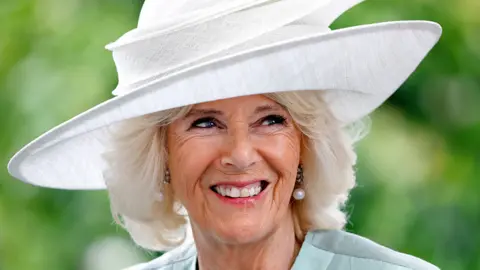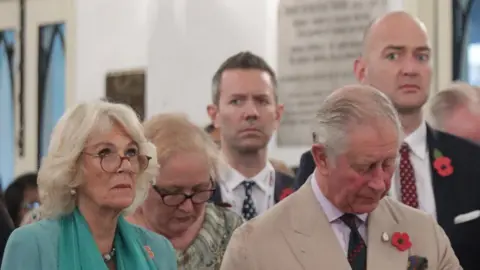Camilla: From tabloid target to crowned queen
 Getty Images
Getty ImagesIt will be a moment, her friends say, that she never thought would happen.
At the Coronation this weekend, the Archbishop of Canterbury will anoint and then crown Camilla as Queen.
Looking back at the early 1990s, when her relationship with the King first became news and the headlines described her as "the most hated woman in Britain" it's hard to believe the crowning of Camilla would ever have come to pass.
For a while, she was one of the most vilified figures in the British media, casually blamed for the break-up of Charles's first marriage to Diana, Princess of Wales.
But in the years between, the public mood has softened. Slowly and carefully she has become accepted as one of the most senior royals.
Eve Pollard was a tabloid editor during the fraught period when Charles's first marriage was being chronicled in every detail across the British media. She later came to know Camilla through charity work, but she admits that at the time, the press went too far and there was an "open season" on this new character in the drama.
"I think it was very cruel because I think we didn't know anything really about the marriage of Charles and Diana. We didn't really know the truth.
"Camilla was at the very, very short end of people's tempers. She never said a word, she never said anything to anybody, and she just held her place."
Camilla has recently appointed six of her oldest friends to be her Queen's Companions. Baroness Carlyn Chisholm is one of them. They will carry out some of the tasks that the late Queen's ladies-in-waiting performed, such as supporting her at public engagements. Every one of them was there during the dark days when the criticism was noisy and harsh.
 Getty Images
Getty ImagesBaroness Chisholm remembers an episode, which she says illustrates her strength of character.
"We used to ride together and there was really never a day went by when we weren't followed by press. We'd come around the corner and they'd be there with cameras."
"She was absolutely calm. She would say, can we take one picture and then can you leave us alone?"
But the photographers didn't generally leave her alone, and they'd be waiting at the next corner.
Camilla, rather than getting angry, would just make the same request and move on again.
"She just seemed to have the strength to know what her character was, how she felt about things… but remain calm."


Friends from her childhood say that much of her character derives from a very secure family background.
She grew up in the idyllic country surroundings of the Sussex Downs.
Journalist and historian William Shawcross was a near-neighbour. He remembers Camilla and her sister Annabel as very independent: "The girls used to be allowed to go out with their ponies on to the Downs on their own and spend the night sleeping… with a sandwich and sleeping bag or rug."
Her parents were both - in their own way - role models when it came to carrying on quietly in the face of adversity. Camilla's father, Major Bruce Shand, was a decorated war hero, who had spent more than two years of World War Two as a prisoner of the Germans. Meanwhile her mother, Rosalind Shand, faced her own painful battle as a long-time sufferer from the bone disease osteoporosis.
In the early 1990s, Camilla was in real need of patience and stoicism. Press attention was growing ever more frenzied. In 1993 the transcript of an intimate phone conversation between Camilla and Charles was published by the Daily Mirror. The story became known as the "tampongate tapes" because at one point, Charles expressed a wish to become her tampon.
There was fresh embarrassment when Princess Diana told the BBC (in a now-discredited Panorama interview) that "there were three of us in this marriage". For his part, Charles said that his romance with Camilla only started after his marriage had "irretrievably" broken down.
In 1994, Camilla and her first husband, Andrew Parker Bowles, began divorce proceedings. A year later Charles and Diana would do the same.
However, it would be another five years before they were finally seen together as a couple.
The public attitude to Camilla began to change during this period, partly due to the appointment of Mark Bolland to the Royal Household in 1997.
Officially he was a deputy private secretary, but his main task was to help repair the troubled public image of both Charles and Camilla. Six years after that first appearance together at the Ritz Hotel in London they were married.
 Getty Images
Getty ImagesIn his memoir, Spare, her stepson Prince Harry was critical of what he saw as a campaign to shift public opinion on Camilla.
But her former communications secretary, Julian Payne, says she was resistant to any orchestrated PR campaign to improve her public standing. He says that she thought it better simply to meet people and let them get to know her and make up their own minds.
Payne says: "I think that that is what people have seen. They've been able to judge her on the work that she's done over those last 17 years, rather than worry too much about what happened a long time ago."
 Getty Images
Getty ImagesWhat happened a long time ago remains part of the Queen Consort's story and why her friends believe she is now so well equipped to take on her role as Queen. Her life has been imperfect, filled with challenge and controversy.
The TV personality and Strictly Come Dancing Judge Craig Revel Horwood became friends with Camilla through charity work for osteoporosis. He says her background makes her stand out as more real than some royals: "The thing about Camilla is that she has had a tough life and she has had major challenges to overcome, and she has been absolutely forward in telling people about herself personally."

Read the latest from our royal correspondent Sean Coughlan - sign up here.

The change in public perception may also owe something to the affection that Charles shows Camilla, and the apparent happiness of their 18-year marriage. In virtually every public speech he delivers he refers to her as his "beloved wife".
The actress Dame Penelope Keith has known the royal couple for decades. She describes Camilla as "a wonderful calming influence" on the King. "He so enjoys her company… I wouldn't presume to say it's changed him, I just think he's very relaxed and now very supported."
The title of Queen brings a mass of responsibilities at the age of 75, when most people have already retired. Craig Revel Horwood is optimistic that this won't be a problem for her: "OK, she's just had her 75th birthday, but you know, she's 25 at heart. She still wants to get up and dance and she still wants to support all of her charities.
 Getty Images
Getty ImagesJulian Payne thinks that she will bring a new perspective on being a Queen: "She had 57 years living in the real world - certainly a world of privilege, but she knows the difference between the royal world and the everyday, and I think her ability to connect the two sides is extremely important."
And what advice do her friends give her for the coronation?
"I just hope she doesn't have to stand for too long," says Dame Penelope Keith. "It's going to be terribly tiring, isn't it?"
Baroness Chisholm will see it all from the comfort of her seat at the Abbey for the Coronation Service.
Watching the Queen Mary Crown placed on her friend's head will be a deeply moving experience for her.
"I think I'm going to take a great deal of Kleenex with me, I'm one of those people who cry at the drop of a hat. Seeing two people you count as your friends doing this role makes it even more emotional."
Additional reporting by Ben Milne, and the BBC R4 Profile programme

What are your plans for the coronation? Email [email protected].
Please include a contact number if you are willing to speak to a BBC journalist. You can also get in touch in the following ways:
- WhatsApp: +44 7756 165803
- Tweet: @BBC_HaveYourSay
- Upload pictures or video
- Please read our terms & conditions and privacy policy

